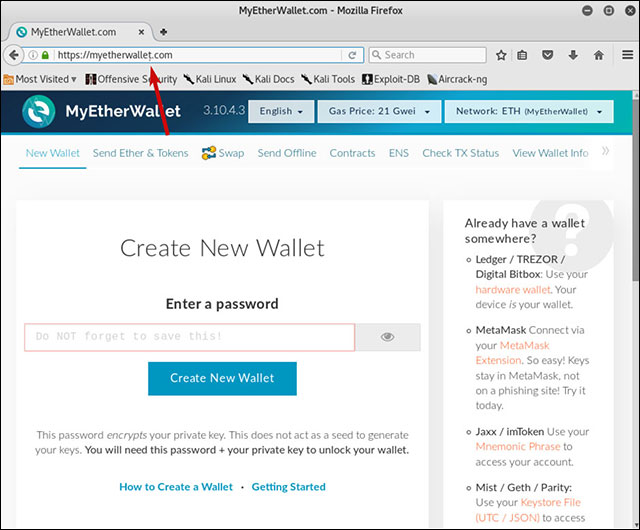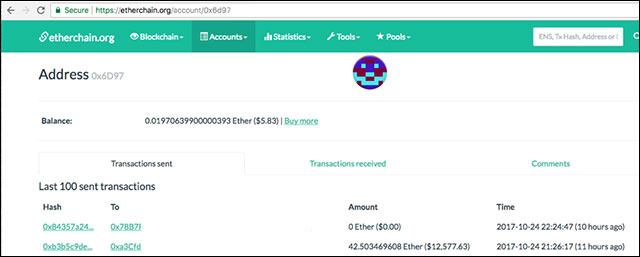Ethereum phishing attacks help criminals earn $ 15,000 in 2 hours
As the value of bitcoin is increasing, more and more people are interested in virtual currencies that are created based on bitcoin and have new features that bitcoin does not have. One of them is Ethereum with the current value of $ 296. It is also the time when people seek to cheat to benefit themselves.
See more: All you need to know about Ethereum
Researcher Wesley Neelen discovered the Ethereum exploit when he received phishing emails from Myetherwallet.com online e-wallet.

Email fraud sent to the victims
This trick says that Myetherwaller has updated and requires users to click on the link available to unlock the account and confirm the balance.
If you click, you will be taken to a page that looks a lot like Myetherwallet.com. But those who notice a bit will see a small comma below the letter t on the page address as shown below.

The website address looks just like a small comma
Scammers do this with Unicode tricks, allowing domain names to contain Unicode characters that look like Latin characters, creating a website that looks very real if you don't look closely.
When the victim enters the password, the attacker will use this password to get into their e-wallet and steal money. Neelen did not have this trap but there were some people who got it.
The attacker sent an email to Neelan without knowing that he was a specialist in testing hacking techniques and evaluating safety by attacking the system to make a living. When he received the trap mail, he investigated the page to see if he could find the source code or access history.

The e-wallet was stolen when plotting the fraud
Through investigation, Neelen also found a history file containing a list of all e-wallet stolen by the fraudster. In it an e-wallet contains 42.5 Ethereum, equivalent to $ 12,500 at the time of the attack. Other wallets also have a total of $ 52.56 ETH, or $ 15,875.65. All are transferred to the scammer's account.
The result is 2 hours of great gain.
You should read it
- Enigma is hacked, more than $ 470,000 Ethereum is stolen
- What is Bitcoin? Why is Bitcoin not 'virtual money'?
- History of digging a bitcoin, from a regular CPU to an ASIC system
- Bitcoin finds its heyday
- Life inside the 'Bitcoin mines' secretly
- Prosecuting two directors of virtual money bitcoin
- How to dig bitcoin without wasting electricity
- Power theft from oil rig to dig Bitcoin, a Chinese man is about to be 'fed the State'
- Ukraine: Catching a railway group of employees stealing electricity to exploit Bitcoin
- Crossing virtual walls, Bitcoin exploded in real life
- VNCERT issued an emergency alert warning malicious code exploiting Coinhive virtual money
- Test of knowledge about Bitcoin
May be interested

Hacker hijack CoinHive DNS to dig virtual money with thousands of websites

Errors on mobile applications allow hackers to control LG devices

Google's new Play Protect system failed from the first test

Matrix Ransomware is back under the distribution of RIG Exploit Kit

The researcher recreates the faded QR code and enters the e-wallet with $ 1,000

6 remarkable security features on Windows 10 Fall Creators Update






![Photo of [Infographic] 4 types of Phishing are easy to trap users](https://tipsmake.com/data/thumbs_80x80/[infographic]-4-types-of-phishing-are-easy-to-trap-users_thumbs_80x80_q5IK2um5z.jpg) [Infographic] 4 types of Phishing are easy to trap users
[Infographic] 4 types of Phishing are easy to trap users What is Spear Phishing?
What is Spear Phishing? GitHub is under strong phishing attack, users pay attention to account security
GitHub is under strong phishing attack, users pay attention to account security New phishing attacks appear to use Google Translate as a disguise
New phishing attacks appear to use Google Translate as a disguise![Photo of [Infographic] How to recognize and prevent Phishing attacks](https://tipsmake.com/data/thumbs_80x80/[infographic]-how-to-recognize-and-prevent-phishing-attacks_thumbs_80x80_DRpd8TNMW.jpg) [Infographic] How to recognize and prevent Phishing attacks
[Infographic] How to recognize and prevent Phishing attacks How to protect yourself from phishing attacks via mobile phones
How to protect yourself from phishing attacks via mobile phones